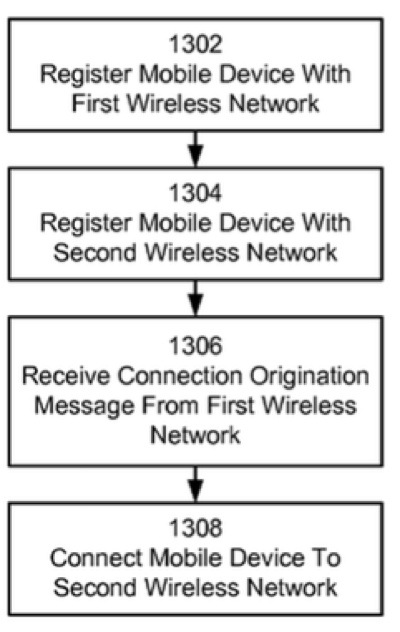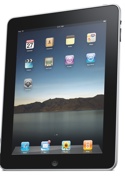An Apple patent (number 20120258707) for multiple network mobile device connection management has popped up at the U.S. Patent & Trademark Office. It involves connection management for mobile wireless devices that support multiple wireless networks where each wireless network can use a different wireless communication technology.
Per the patent, a mobile wireless device maintains registration on two parallel wireless communication networks that each use different wireless communication protocols. In response to a first connection request received from a first wireless network, the mobile wireless device tunes a single receiver contained therein from the first wireless network to a second wireless network. Subsequently in response to a second connection request received from the second wireless network, the mobile wireless device connects to the second wireless network.
Here’s Apple’s background and summary on the invention: “Wireless networks continue to evolve as new communication technologies develop and standardize. Current wireless network deployments include many variations in architecture, including support for multiple wireless communication technologies simultaneously by one or more wireless network service providers.
“A representative wireless network for a wireless network service provider can include support for one or more releases of wireless communication protocols specified by the Third Generation Partnership Project (3GPP) and Third Generation Partnership Project 2 (3GPP2) communication standards organizations.
“Dual receiver mobile wireless devices can include separate sets of circuitry known as receive signal chains for receiving signals from different wireless communication networks that can operate according to different wireless communication protocols that can use different wireless communication technology, particularly in the radio frequency access network portions of the wireless communication network.
“With separate receive signal chains, a dual receiver mobile wireless device can connect simultaneously to two different wireless communication networks that can use two different wireless communication technologies. The dual receiver mobile wireless device can independently receive pages from one wireless communication network, e.g. a CDMA2000 1x wireless network, through one receive signal chain and also receive pages from a second wireless communication network, e.g. an LTE wireless network through a second receive signal chain.
“Even when the dual receiver mobile wireless device is connected to and actively transferring data through the LTE wireless network using one of the receivers, the dual receiver mobile wireless device can receive a page requesting a separate voice connection from the CDMA2000 1x wireless network through a second receiver. Thus the dual receiver mobile wireless device can establish a mobile originated or a mobile terminated circuit switched voice connection over the CDMA2000 1x wireless network while also remaining connected to (or camped on) the packet switched LTE wireless network.
“A single receiver mobile wireless device, however, can only camp on one wireless communication network at a time, e.g. either on the evolved Universal Mobile Telecommunications System (UMTS) Terrestrial Radio Access Network (eUTRAN) of the LTE wireless network or on the radio access network (RAN) of the CDMA2000 1x wireless network, but not to both wireless communication networks simultaneously.
“When the LTE wireless network does not support a circuit switched fall back (CSFB) mode or provide for voice over LTE (VoLTE) connections, the single receiver mobile wireless device can be unable to receive a page from the CDMA2000 1x wireless network and to establish a mobile terminated voice connection with the CDMA2000 1x wireless network when camped simultaneously on the eUTRAN of the LTE wireless network.
“Thus, there exists a need for a method whereby a single receiver mobile wireless device can achieve similar functionality to a dual receiver mobile wireless device, so that the single receiver mobile wireless device can retain the ability to complete a circuit switched voice connection through a first wireless network, such as the CDMA2000 1x wireless network, when camped on a second wireless network, such as on the eUTRAN of a parallel LTE wireless network.
“In one embodiment, a method of managing connections between a mobile wireless device and a plurality of wireless networks is described. The method includes at least the following steps. In a first step, the mobile wireless device registers with a first wireless network and also registers with a second wireless network. Subsequently, the mobile wireless device receives a connection origination message from the first wireless network and in response connects to the second wireless network.
“The first and second wireless networks each use a different wireless communication protocol. In some embodiments, the mobile wireless device sends a connection rejection message to the first wireless network before connecting to the second wireless network. In an embodiment, the first wireless network uses a 3GPP LTE wireless communication protocol and the second wireless network uses a 3GPP2 CDMA2000 1x wireless communication protocol.
“In another embodiment, a mobile wireless device including a receiver and a configurable processor is described. The receiver is tunable to receive signals from a first wireless network and also to receive signals from a second wireless network. The processor is configured to register the mobile wireless device with the first and second wireless networks.
“The processor is also configured to receive a connection origination message from the first wireless network and in response establish a connection between the mobile wireless device and the second wireless network. The first and second wireless networks each use different wireless communication protocols.
“In a further embodiment, non-transitory computer program product encoded in a non-transitory computer readable medium for managing connections between a mobile wireless device and a plurality of wireless networks is described. The non-transitory computer program product in the mobile wireless device includes the following non-transitory computer program code. Non-transitory computer program code for registering the mobile wireless device with a first wireless network and with a second wireless network.
Non-transitory computer program code for receiving a connection origination message from the first wireless network and in response connecting the mobile wireless device to the second wireless network. The first and second wireless networks each use a different wireless communication protocol. In some embodiments, the non-transitory computer program product also includes the following non-transitory computer program code.
Non-transitory computer program code for releasing one or more radio access bearers between the mobile wireless device and the first wireless network and for sending a connection rejection message to the first wireless network in response to receiving the connection origination message from the first wireless network. In addition, non-transitory computer program code for tuning the receiver of the mobile wireless device from the first wireless network to the second wireless network and for receiving a connection request from the second wireless network. In an embodiment, the connection origination message is a SIP invite message, and the connection rejection message is a SIP reject message.
“Although described in terms of a CDMA2000 1x wireless network and an LTE wireless network, the embodiments disclosed herein can be extended to include GSM networks and UMTS networks as well.”
The inventors are Arun G. Mathias, Madhusudan Chaudhary and Jiznxiong Shi.



